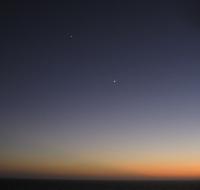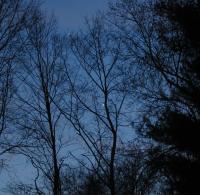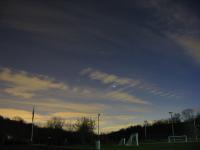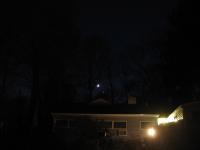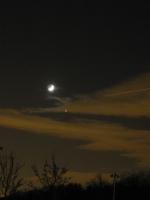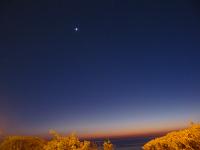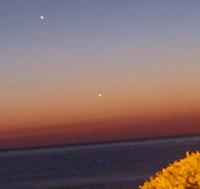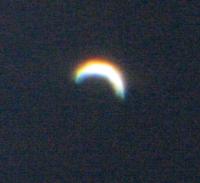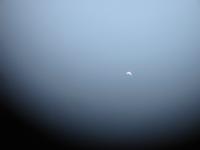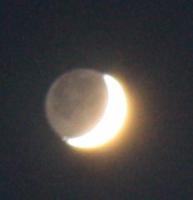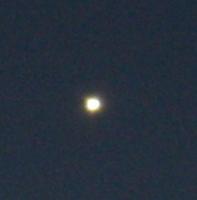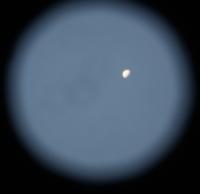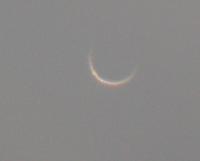Printable Version of Topic
Click here to view this topic in its original format
Unmanned Spaceflight.com _ Venus _ brightness of Venus
Posted by: ncc1701d Dec 21 2007, 07:28 PM
I was wondering.
If Venus reflects 70 percent of the sunlight that hits it.
If I was in spaceship on approach to that planet could I look at it with the naked eye out the window and not get blinded?
Would I have to at least use sunglasses?
I am wondering to how much brightness reduction is going on when processing the images before they are release to public or analized.
thanks
Posted by: ngunn Dec 22 2007, 11:14 PM
I would recommend sunglasses at least. Even at Earth's distance from the sun bright clouds or snow are bright enough to cause discomfort. At Venus the intensity would be about double. We evolved in warm latitudes where the brightest thing around was sand.
Posted by: ugordan Dec 23 2007, 12:04 AM
If you were in a spaceship, even Earth would appear almost uncomfortably bright (at a distance to render a planet a small orb) due to the fact the eye was trying to compensate for the blackness of space. Venus would, by far, be brilliant to human eyes and you'd want more than good sunglasses, I'd think. In fact, being closer to the planet you might actually feel the sun's heat reflecting off its clouds on your face.
Posted by: edstrick Dec 23 2007, 10:31 AM
Something I've worried about is a hazard when you go beyond Earth's orbit. Sun-blindness.
People with normal eyes can look at the sun. Staring at it's bad, but evolution's prepped us to be able to glance at it or have it in our peripheral vision without frying our retinas in a hurry.
When you go out to Mars orbit and beyond.. the sun gets smaller.. and dimmer... but not with any lower surface brightness.
As you get out to the belt and Jupiter's orbit, the sun's getting really small, with a total angular-arc-minutes of area like the sun during the near-total stages of a solar eclipse... THE ONES WHERE PEOPLE FRY THEIR RETINAS!.
The problem is that as total brightness drops, the iris starts to open a bit from sun-safe maximum constriction.. and the brightness per square micrometer on the retina rises to "sizzling" levels.
People exploring beyond the sun may need active, smart eye-tracking, eye-shielding self-opaquing optics in suite helmets and the like, and windows that automatically darken or blur when the sun is visible.
Posted by: Stu Dec 23 2007, 10:41 AM
... brings to mind a true story. 1999, August... there's a total eclipse of the Sun visible from the extreme SW of the UK, everywhere else in the UK will see a good partial eclipse. As Secretary of my town's astro society I've organised a big "Eclipse Watch" event (later attended by over 1000 people, it was fantastic!!!) and am being interviewed on local TV and radio a lot about it, and have info pieces in all the local papers too, stressing again and again and again the safety aspects of observing the eclipse: only use eclipse glasses or pieces of VERY dark welding glass if they're safe... don't use smoked glass, CDs, Penguin or Kit Kat foil wrappers or anything else like that, they're not safe at all, and if you can't get any glass or glasses then prick a hole in a piece of card to make a "Pinhole projector" and watch the eclipse by projecting the Sun's image thru the card onto a wall. I figured I had all the bases covered. Common sense, right?
The night before the eclipse, my phone rings, and no surprise it's another caller asking for eclipse watching advice. "I saw your piece in the paper, and I have bought some eclipse glasses," the lady tells me. "But do I prick a hole in BOTH sides to look at the Sun through, or just one..?
Posted by: J.J. Dec 23 2007, 03:46 PM
A pretty interesting question, one I've speculated about myself...
I did a little back of the envelope calculation, using the differences between Earth and Venus's albedos, comparisons between the Moon and Earth's diameter a one lunar distance (as a baseline), the different solar constant between Earth and Venus, basic geometry, and finally the distance of geostationary orbit (for Earth, anyway) as the final comparison.
My very crude results suggest that at a distance from Venus equivalent to geostationary orbit around Earth (~35,800 km), Venus would be roughly 28,000 times brighter than the full Moon appears from Earth. Though its light would be spread over an area about 1,570 times greater, it would still be almost 18 times brighter per square arcsecond than the full Moon. In sum, I do think it would be hard on the eyes, and probably dangerous for long periods.
Feel free to check my figures, people...
Addendum:
A slightly less aggressive calculation still suggests Venus would be about 10 times brighter than the full Moon per square arcsecond...
Posted by: dvandorn Dec 23 2007, 04:50 PM
I'd just like to bring into this conversation the experience of the guys who have dealt with something similar -- those who went to the Moon.
Now, the Moon is a lot darker than Venus, by something like an order of magnitude. It reflects a lot less light. But astronauts who operated in orbit around it, or on its surface, regularly wore sunglasses, and skipped the sunglasses at their own peril.
As one example, John Young, on Apollo 16, decided he didn't need sunglasses when preparing for ascent from the lunar surface, and ended up riding into orbit in an almost completely sun-blinded condition. Per his own statements in debriefing, Young couldn't really see anything during ascent, and he blamed it on sun-blinding from the brightly illuminated surface. (Granted, the highlands site where Young and his LMP, Charlie Duke, had landed was of a higher albedo than other landing sites, but not that much higher.)
So, if the Moon can cause sun-blindness in those who don't take the proper precautions, I can just imagine how much greater the problem would be in orbit around Venus.
-the other Doug
Posted by: J.J. Dec 23 2007, 05:29 PM
^
Ditto--and the Sun is twice as bright at Venus's distance, to boot.
Posted by: JRehling Dec 23 2007, 10:39 PM
The John Young incident is interesting, and not one I'd heard before. And a priori, it's somewhat surprising. After all, the Earth is lit almost as brightly as the Moon, and in many places has higher albedo. And sunglasses are not de rigeur on Earth.
My guess is that the black sky is to blame. With the visual field partly taking in sky, the difference between the Earth's blue sky (which is not so bright as to cause damage with sustained foveation) and the utter blackness of the lunar sky should make a difference in pupil diameter. I guess that staring down at the Moon would be less of a problem than doing a lot of sky gazing with a few quick glances down at the Moon.
Posted by: dvandorn Dec 24 2007, 07:45 AM
Many of the Apollo astronauts chose to wear sunglasses when doing a lot of "out of the window" stuff both in lunar orbit and on the surface -- and, of course, the LEVVA visor assemblies had built-in sunglasses (the outer gold-coated visor).
Pete Conrad almost landed on the Moon wearing sunglasses inside his bubble helmet, but all of the standard-issue sunglasses back then were the green-tinted kind, and Pete decided rather late that the green shading washed out too many details. But he indeed removed his helmet and took off his sunglasses just prior to descent.
As for Young, recall that 1) the Descartes landing site was in one of the highest albedo terrain units the Moon has to offer, and 2) by the time they lifted off, Young and Duke were sitting under the highest Sun angle anyone in Apollo would ever see from the surface (owing to their three-rev, six-hour landing slip). Add to that the airlessness, which not only gave the pure black sky in contrast to the brightly lit surface but also allowed full unfiltered Sunlight to beat down. Any place on Earth lit with that kind of unfiltered Sunlight would likely make you "snowblind," as well.
-the other Doug
Posted by: PhilCo126 Jan 2 2008, 05:42 PM
Talking about a bright Venus, ESA made a website on which observers can contribute and download their images of our sisterplanet:
Wanted: Your pictures of planet Venus:
www.rssd.esa.int/vaa
Posted by: PhilCo126 Nov 25 2008, 05:42 PM
Looking South these winter evenings, You'll notice 2 bright spots, the lower one is Venus, the upper one is Jupiter.
Good binoculars show Venus as a half disk and Jupiter's moons were on the left side of the gas giant this evening.
Remember that by the end of the month, the Moon, Jupiter and Venus will be very close together.
Best time to watch: For West-Europe: 16:30 GMT
![]()
Posted by: Stu Nov 25 2008, 05:47 PM
This is how they looked this time last week from n California...
Posted by: CAP-Team Nov 26 2008, 10:04 PM
Yes, Venus and Jupiter look very nice in the evening sky this month!
Posted by: scalbers Nov 27 2008, 06:55 PM
I suppose I need sunglasses just being on Earth's surface in Colorado where there is more UV than at many other locations. And I really need them when flying in an airplane looking down at bright clouds. So I can further imagine how they would be needed in orbit around Venus.
Posted by: Enceladus75 Nov 27 2008, 10:09 PM
I saw a stunning view of Jupiter and Venus in the Irish sky this evening. Makes me proud to be a part of this fantastic solar system. ![]()
Posted by: bkellysky Nov 29 2008, 12:24 AM
Here's Jupiter and Venus, just after sunset on Thursday night peeking through some trees in back of my house, north of New York City. I used my Canon A40 camera on a tripod, 3x zoom, 1/2 second exposure, cropped to save uploading space.
bob
Posted by: bkellysky Nov 30 2008, 12:11 AM
Jupiter with brighter Venus below it. I took this photo one hour after sunset here on the east coast of the United States.
The Moon joins the picture Sunday evening and pulls up alongside on Monday. The weather is forecast to be raining here in the NYC area Sunday evening and mostly cloudy on Monday evening, so this may be the best shot of the series for me.
This was a 10 second exposure with my Canon A40 on a tripod. The long exposure brought out the wave clouds, barely visible to the unaided eye and made the sky look bright.
bob
Posted by: bkellysky Dec 2 2008, 02:01 PM
Photos of the conjunction of the Moon, Venus and Jupiter last night, making a triangle in the trees behind my house.
The two "stars" on the left and the one above are camera artifacts!
1 second exposure, canon a40 on a tripod
bob
Posted by: bkellysky Dec 2 2008, 02:04 PM
A second photo from last night's conjunction - over an hour after sunset, as clouds started to move back in over us. The photo is a 10 sec exposure with my Canon A40 on a tripod, 3x zoom. The clouds show up because of the local street lights and the long exposure. While the crescent moon is overexposed, the earthshine on the moon show up nicely in this photo.
The streak of lights on the right is an aircraft that moved in during the exposure.
bob
Posted by: PhilCo126 Dec 17 2008, 04:43 PM
For those UMSF members/lurkers still observing the Planet Venus and Jupiter, do go out with Your binoculars/telescope as we have 4 planets in a row this week:
Posted by: bkellysky Jan 16 2009, 10:04 PM
My most recent photo of the sky with Venus is from back on January 4th, when my wife and I were visiting La Jolla, California. In the larger photo, Venus is to the upper left, with Mercury and Jupiter on the lower right. The smaller photo is a cropped version of the larger one, and you can see Jupiter to the lower left of Mercury and, if you look closely, it looks like a reflection of Jupiter in the water, [but as ugordan and andyg have pointed out, what looks like it might be a reflection is not in the right place- thanks to them for the info!] . The color of the foreground is from local street lights.
It was easier to see Jupiter and Mercury because of the flat ocean horizon on the west coast of the US.
Venus will be hanging out in the evening sky through the end of February, but Jupiter and Mercury are too near the sun to be easily seen, at least in the northern hemisphere.
bob
Canon A40 on mini-tripod on the beach at La Jolla, California, USA, 15 second exposure.
Posted by: AndyG Jan 17 2009, 01:25 PM
How high above the ocean were you? "Common sense" would say, if not much, then the reflection should be lower down the image.
Regards,
Andy
Posted by: ugordan Jan 17 2009, 03:06 PM
Jupiter's reflection (if any) would be vertical to the sea/horizon line, not vertical to the image.
Posted by: bkellysky Jan 17 2009, 03:54 PM
Good points! It must just be a camera artifact, that just happened to be in the location where it would be, if the horizon wasn't tilted.
I'll edit the post.
all the best,
bob
Posted by: bkellysky Apr 18 2009, 12:38 PM
If people don't mind my using this thread to show the visibility of Venus in the sky.....
Low in the east just before sunrise, Venus looks like an airplane headlight. BTW, there is another "headlight" well to the right of Venus, it's Jupiter. But wait, there's more.... for this week only, the Moon is putting in a guest appearance. The moon will pass by Jupiter on Sunday and Monday, and in some parts of the USA, the Moon will hide Venus early Wednesday morning.
Check out the charts from Sky and Telescope:
http://www.skyandtelescope.com/observing/highlights/43111187.html
Attached is a view through my 8-inch dobsonian telescope (cropped to save bandwidth).
You, too, can see crescent Venus in a telescope or even through (steadily held) binoculars, but Venus is soooo bright that the crescent shape can be hard to see in the dark due to the glare. It's actually easier to see as the sky gets brighter.
The photo has some extra color due to the optics and because this is a handheld shot through the eyepiece. Canon A40 at 1/125 sec, ISO 400 and the camera zoomed at 3X.
Posted by: bkellysky Apr 24 2009, 11:31 AM
Some parts of the United States got to see Venus eclipsed by the moon on Wednesday morning.
It was cloudy here in the NYC area before sunrise, but I did get to see the moon and Venus together about 8:20am EDT (two hours after sunrise) as a line of clearing skies passed by.
I used my 8x25 binoculars. I found Venus first, waiting until the clouds thinned enough to see it. Only then could I see the moon next to it, looking like a ghost. It reminded me of those space art paintings that showed a giant moon hanging in the daylight sky over some alien planet.
Those who saw this would easily see how much brighter the surface area of Venus is compared to the moon. It's even more striking after sunrise thanks to the brighter background sky. In the dark, Venus and the moon are both blindingly bright.
Some really great photos are at Spaceweather.com. My favorite is on the archived page for April 23rd. My viewing, with them in and out of the edge of a line of clouds, was too brief for a photo.
bob
ps astronomy photo of the day site today has a great photo!
Posted by: bkellysky Apr 24 2009, 11:44 AM
Here's a shot of Venus through my 8-inch Dobsonian, with an eyepiece that gives 40 power. It gives some idea of what Venus looks like through a telescope.
I held the camera up to the eyepiece with the camera at 3x zoom. It's not quite centered, but it gives a feeling of seeing Venus through the eyepiece.
I took the photo about 6:30am EDT, about 25 minutes after sunrise. The camera is a Canon A40, a 1/250 second exposure at F4.8 .
I had a movie clip, but it's over 1MB, so it won't fit here.
bob
Posted by: bkellysky Jun 16 2010, 12:42 AM
Venus is now a brilliant object in the western sky after sunset.
Some good photos of Venus and the Moon (including mine) are on www.spaceweather.com- check the archive for June 15th or look at the spaceweather photo secton of the website.
bob
bkellysky.wordpress.com
Posted by: bkellysky Jun 16 2010, 11:47 AM
Last night, I was taking pictures of Venus, et al., after sunset, when someone asked me what the bright light next to the moon was. He said he figured I'd know, since I had the camera/tripod set up. I told him it was Venus and that some of the other dots to the upper left were a bright star, and the planets Mars and Saturn. "But you can't see those," he said and resumed walking around the track as I called after him, "Yes, you can if look when you are on the darker side of the track....." Maybe if I had the telescope and after looking though the scope, I had pointed out in the sky what we were looking at, he might have understood.
Amazing what people think they can't see, and really could if they looked for a moment.
Of course, that's when people start moving away from the crazy guy with the camera.....
Here's the Moon and Venus, cropped from a larger photo posted at bkellysky.wordpress.com....
Notice the earthshine on the Moon and the dot of light at the lower left end of the lunar crescent, separated from rest of the sunlit portion. This is likely a lunar mountain or crater wall sticking up into the sunlight, but I didn't have my binoculars to check.
Venus is an overexposed blob, but I've included it here for comparison.
bob
Posted by: bkellysky Jul 6 2010, 01:17 AM
Venus, through my 8-inch dobsonian telescope, in the late afternoon from my house north of New York City.
It's easy to see that Venus is a little bit more than half-full at this point.
Venus is harder to find in the daylight, but the bright background can make it easier to see the phase of Venus. Sometimes the phase is hard to see at night because Venus is so bright.
I've posted details at my Heads UP! blog at
http://bkellysky.wordpress.com/
bob
Posted by: ElkGroveDan Jul 6 2010, 02:36 AM
Wow. Thanks. I do believe that's one of the best Earth-based images of Venus I have ever seen.
Posted by: nprev Jul 6 2010, 02:41 AM
Agreed. I've always heard that Venus was often best viewed in daylight; now I believe it!
Posted by: Hungry4info Jul 6 2010, 04:05 AM
I watched the most recent occultation of Venus by the moon with my telescope (14 cm reflector). It was definitely daylight, sun was up and all. Couldn't see Venus with the naked eye but could certainly see it through the telescope.
As bkellysky said, it definitely looks better against the background (foreground I guess) of the sky. The lighting difference isn't so great and you can much better make out the shape of the planet's phase.
It's more challenging to do, but definitely go out and observe Venus during the daytime. You won't regret it ![]()
Posted by: bkellysky Nov 4 2010, 01:52 AM
Crescent Venus with a Canon XS and my 8-inch dobsonian telescope.
Venus is in front of the sun, in the sky about a fist width to the upper right of the sun (the distance increases every day). I was able to find Venus in 8x25 binoculars, then pointed my telescope in the same area. Venus is large for a planet and a thin crescent.
See my blog for the full photo, cropped here to save space.
The rainbow colors are due to the turbulent atmosphere and camera motion. Venus was only about 10 degrees above the horizon at the time, a half hour after sunrise.
I haven't seen it without binoculars, but Venus is amazingly bright once you find it and the crescent shape could be seen by other people with the binoculars when I told them where to look.
bob
http://bkellysky.wordpress.com/
Posted by: AndyG Nov 4 2010, 09:46 AM
Nice one, Bob - though I was a bit ![]() before reading on your blog "...I blocked out the sun".
before reading on your blog "...I blocked out the sun".
Thank goodness for that.
Andy
Posted by: bkellysky Nov 10 2010, 03:45 AM
Venus was impossible to miss, low in the southeast, less than 30 minutes before sunrise this morning.
It showed a tiny crescent shape in 8x25 binoculars, which was easier to see as the sky got brighter.
I'll try to get a photo Thursday morning (the forecast for Wednesday morning is cloudy).
bob
Posted by: bkellysky Nov 11 2010, 02:13 PM
Anytime up to an hour before sunrise, Venus is brilliant. I've posted an example at http://bkellysky.wordpress.com/
Posted by: bkellysky Nov 12 2010, 12:19 PM
This morning's photo of a skyscape including Venus and Saturn is at my blog (at 3MB, too big for this server)
http://bkellysky.wordpress.com/
Also posted at the Weather Channel at
http://iwitness.weather.com/_Morning-Planets/photo/11666872/148597.html
Powered by Invision Power Board (http://www.invisionboard.com)
© Invision Power Services (http://www.invisionpower.com)

